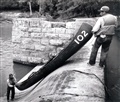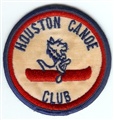First Annual Texas Water Safari
Feb. 2012
by Jeannine Maughmer Miller
“Hey, coppers. Coppers!” Stan Slaten, a Houston Chronicle reporter yelled. “Are you guys going to finish this thing?”
|
 |
|
Photo by Bob Brister.
Lynn Maughmer with canoe.
Jimmy Jones laying comatose
on beach.
|
“Is he still alive?” Bob Brister, a photographer standing next to Slaten, asked, snapping pictures of Jimmy Jones as he lay comatose on the beach, his lifeless arms floating up and down to the rhythm of the sea, his Kapok life jacket barely keeping his head out of the water. Lynn Maughmer’s tattooed arm lay across the bow of their canoe, marked with #102. Maughmer splashed salt water into his sunburned and parched face, wrenched in pain, wretched, threw up, and splashed water on himself again. He thought he was hallucinating again but looked toward the sound of the voices.

|
|
|
Jimmy Jones on top
with Lynn below dam
|
|
Touted as the longest and toughest boat race in the world, 58 boats and 120 participants left San Marcos on April 29, 1963 to begin the 12-day, 500-mile race to Corpus Christi. The teams endured grueling days of portaging log jams and dams and a two mile stretch of road. They battled snakes, mosquitoes, and black wasps. They fought to stay afloat over waterfalls, rapids, and against horrendous winds and huge waves that pummeled both man and boat. By the last day of the open bay crossings, only two boats remained in the running. And one of them was missing.
The history of the Texas Water Safari began one afternoon in 1962, in San Marcos, Texas, during an archery competition. Frank Brown, the Manager of the San Marcos Chamber of Commerce, asked his friend, Bill George of Big Willy’s hamburger restaurant if he knew of anyone who had taken the San Marcos River all the way to the Gulf of Mexico. It was determined that no one knew of anyone who had. Being an avid outdoorsman, George asked Brown when he wanted to go.
Brown believed the rivers could be a great tourist attraction and aide in bringing attention to the small town of San Marcos. According to Marc W. McCord, who interviewed Frank Brown’s sons, George and Brown set out in a 12-foot, semi-V hull, Lone Star, wide-beam row boat to navigate the San Marcos and Guadalupe rivers and their dams, rapids, portages and dangers. The two men took everything they needed, re-supplying only through fishing, hunting and trapping. It took them about 21 days to get to the Gulf. The publicity that Brown and George gained from this adventure is what gave Brown the idea of hosting an annual Texas Water Safari, beginning in 1963.
The rules of the first annual water safari race were simple. The boat had to be powered by man, not motor. You couldn’t restock or be given anything by anybody, not even another participating team. If your equipment failed or broke, you repaired it with what you had or could scavenge. If you lost everything, you improvised, adapted and lived off the land. Or you quit.
Fred Hurd, an airplane mechanic and co-pilot, and his partner, Sam Hare, a pilot, both worked for the Humble Oil Company in Houston. They were friends with my father, Lynn Maughmer, who was a Houston police department motorcycle officer, and his race partner, Jimmy Jones, who was a Homicide detective. My father signed himself and Jimmy up for the race before he asked Jimmy if he wanted to go. Jones was surprised to find that it was a 12-day jaunt with no restocking. They didn’t even have a canoe. “A minor detail” my father said. Through a sponsor they were able to get a canoe, which my father welded a sculling seat and oar locks to. He thought this would be a faster way to navigate through the water although it added weight to the vessel.
On April 29, 1963, with 58 boats and 120 participants, a starting pistol began four waves of teams paddling or rowing down Spring Lake at Aquarena Springs in San Marcos. This race would take participants from the San Marcos River to the Guadalupe River, then across Haynes Bay, Intercoastal Canal, San Antonio Bay, Aransas Bay and Corpus Bay, ending at Ingleside. Although Corpus Christi was the official finish line, Ingleside was the last check point for participants times to count.
The vessels had to be light enough to be carried over these portages, yet heavy enough to withstand the battering of open seas. There were many physical injuries and much exhaustion by the fourth day of the race.
All entrants drank from the river, using purifying tablets. Parts of the river had no banks, only high cliffs. So if an animal fell in or was swept away from crossing it, there was no place for them to get out and they would drown, polluting the water. Many of the racers were troubled with stomach cramps, diarrhea, and constipation from drinking contaminated water.
|
 |
|
Photo by E P Haddon.
Left to right: Lynn Maughmer
and Fred Hurd with back to
camera. Jimmy Jones sitting
next to unknown man in
cowboy hat. Sam Hare in
background.
|
Only 19 boats made it to Austwell where participants were held up by the United States Coast Guard until all canoes were accounted for. They wanted all boats to start the bay trek of the race at the same time, making rescue easier. By the end of the first day of the bay crossing, only 13 boats remained. Three had been disqualified for cheating along the way.
Upon reaching the open seas racers faced 32 mile an hour winds and 5 foot waves that pummeled both man and boat. Reefs tore their rudders and paddles. Masts broke under the pressure. By the second day of the open bay crossings only 2 boats remained in the running. And one of them was missing.
On May 9, the last day of the race, all entrants had to be in Ingleside, the final check point, before sundown or they were disqualified. The race counted actual elapsed time from all check points so regardless of who came in first, the winner was the crew with the best time. Hurd and Hare were in second place but had reached the finish line in Ingleside first. The first place team, canoe #102, with my father and Jones in it, was missing and feared to have capsized.
Hurd knew that if the #102 didn’t make it in on time, he and Hare would be declared the winners even though my father and Jones were 35 hours ahead of them.
Unbeknownst to anyone, just a few hundred yards away from the finish line, Slaten and Brister had found the missing team on the beach.
“Come on.” Slaten encouraged. “It’s just a little further.” he lied, knowing they had at least 800 yards to go. “Don’t you want to finish?”
With no answer from Maughmer or Jones, Brister finally goaded them by saying, “Fred Hurd said that if you’re such a big damn baby, you shouldn’t have started this thing to begin with.”
With that my father mustered all the strength he had left, threw Jimmy in the canoe and headed across the bay. With a broken oar lock and broken and crudely mended paddle, they hoisted their sail but the mast broke, nearly capsizing them. Determined to finished, they persevered against all odds.
Hurd looked out onto the horizon and saw the #102 going the wrong way. In a great show of sportsmanship, Hurd started waving his arms and yelling at Maughmer and Jones.
“Over here.” He yelled. “Hey, over here.” He flailed his arms. “You’re going the wrong way.” But neither man could hear him. Hurd turned to the high school band and yelled, “Play something.” As the music began to waft across the bay, the #102 turned toward the sound.
One reporter asked Hurd, “Why did you do that? You could have been first place.” As was his humble fashion Hurd answered, “I’m not going in without my friends.”
As Maughmer and Jones struggled to get to the finish line, a boat full of reporters and photographers came close to the #102, bumping into it. My father knew that if they capsized now, neither he nor Jimmy would have the strength to get back in the canoe. He threatened the reporters lives with a few choice words, if they didn’t get away from him. The #102’s official finish time was 7:18 p.m., a mere 12 minutes before the official deadline. Brister’s final report on May 10, 1963, said “In an almost superhuman display of raw courage and determination, two Houston policemen dragged their damaged boat across the finish line here today to hold their lead in the Texas Water Safari survival race. Lynn Maughmer and Jimmy Jones were so exhausted they fell repeatedly face first on the shoreline, attempting to drag their crippled canoe across the finish line before the deadline at 7:30pm, here in Ingleside.”

|
|
|
Photo by G. W. Shafer,
Police Photographer.
Lynn Maughmer in uniform, and
Jimmy Jones, holding trophy, at a
a news conference in front of the
Houston Police Department at 61
Riesner.
|
|
My father and Jones credited the skulling seats and rowing oars with their ability to win.
In the 1964 race they teamed with Fred Hurd and Archie Clark to become the first four-man team to finish and they took fourth place. In 1965 Maughmer and Jones teamed with Fred Hurd’s son, Kenny, and became the first three-man team to finish, also taking fourth place.
|
|

|
|
HCC Bobcat Logo |
This experience and the friendships that developed were the impetus for chartering the Houston Canoe Club in 1964. My father, an artist, drew the bobcat in a canoe as the symbol for the patch. No one really knows why it was a bobcat other than it was for the initials of Canoe Association of Texas (C.A.T.). Not being a domestic cat lover, my father no doubt went with a stronger, more virile feline.
My father died in 1968 from stomach cancer and Jimmy Jones retired from the Houston Police Department and moved to Bastrop, where he died from lung cancer in 2002.
Fred Hurd lives in California and I’m not sure what happened to Sam Hare.
|
The author,
Jeannine Maughmer Miller
Contact: busybay12@yahoo.com
|

|